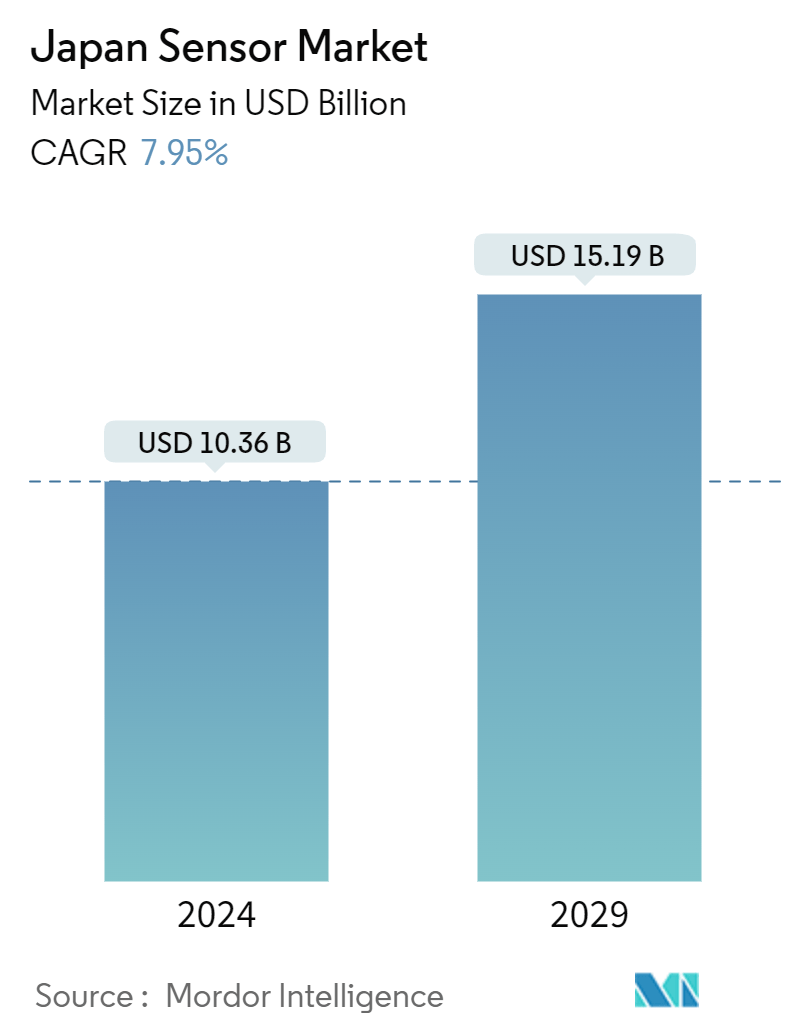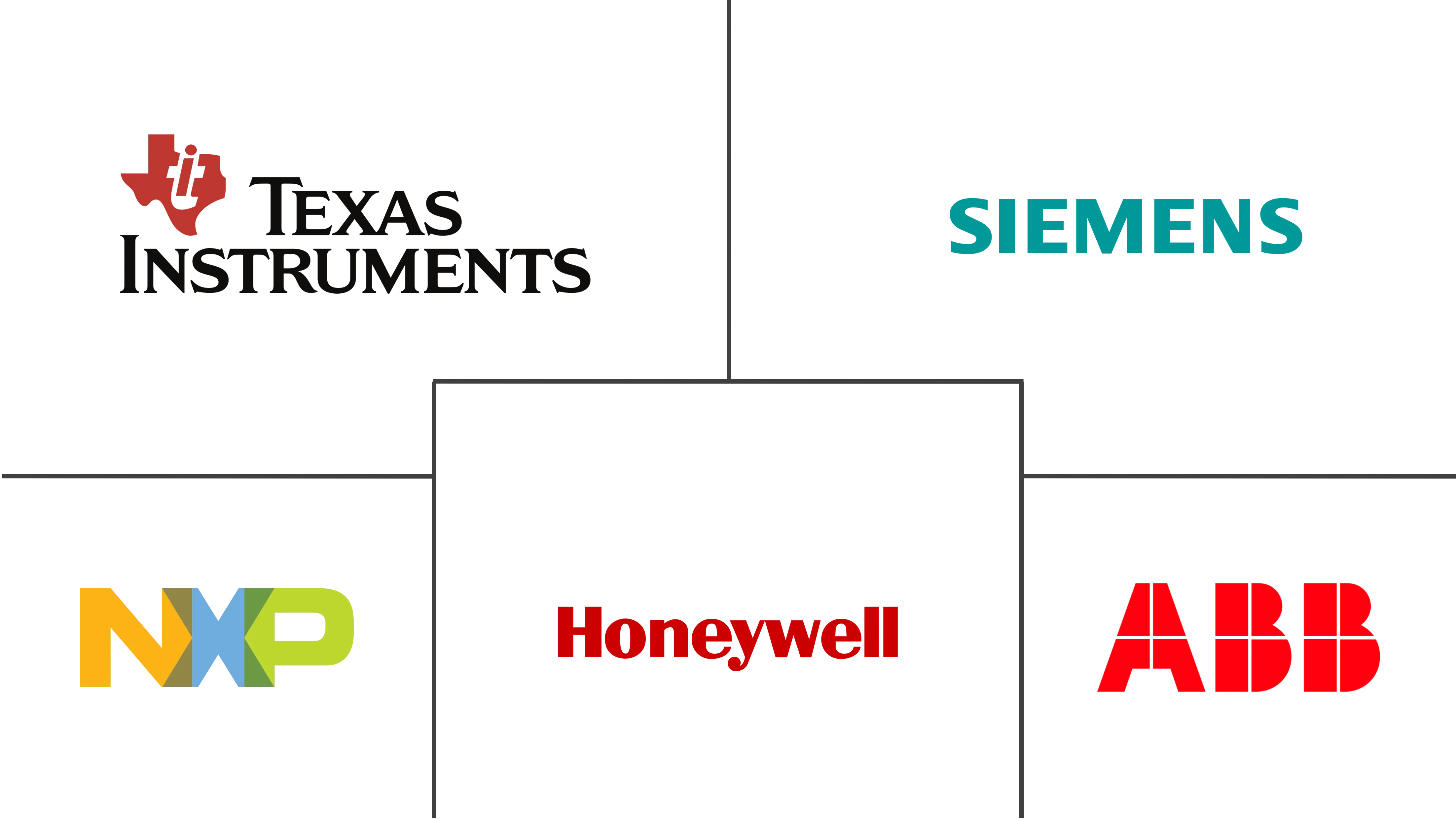Market Size of Japan Sensor Industry

| Study Period | 2019 - 2029 |
| Base Year For Estimation | 2023 |
| Market Size (2024) | USD 10.36 Billion |
| Market Size (2029) | USD 15.19 Billion |
| CAGR (2024 - 2029) | 7.95 % |
| Market Concentration | Low |
Major Players
*Disclaimer: Major Players sorted in no particular order |
Japan Sensor Market Analysis
The Japan Sensor Market size is estimated at USD 10.36 billion in 2024, and is expected to reach USD 15.19 billion by 2029, growing at a CAGR of 7.95% during the forecast period (2024-2029).
The adoption of sensors has continuously increased due to technological developments in automotive, healthcare, industrial, and other sectors.
- The future switch of the Japanese smart city market to energy-efficient and conservation-related solutions in Japan may directly influence the demand for sensors from early adoption to mass adoption. The rising demand for home automation is driving the development of advanced sensors to reduce cost and power consumption.
- The demand for fitness and health monitoring devices is rising due to their frequent integration into everyday lives. The demand for smartwatches, activity trackers, and other personal digital health devices is growing. New sensors, such as Barometric pressure sensors, are being developed by companies that are ideal for applications such as embedding in watches, fitness bands, earphones, or smartphones to support fitness parameters, enable higher accuracy of physical activity, and allow enhanced analysis of activity being done.
- The government is taking several initiatives to support the adoption of robots in Japan, further propelling the demand for sensors. For instance, the "New Robot Strategy" was introduced in Japan to make the country the world's number one robot innovation hub, with more than USD 930.5 million in financial support provided by the Japanese government in 2022. Thus, with the rising production and deployment of robotics in the manufacturing sector, the sensor market is expected to observe rampant growth because robots require a wide range of sensors to operate effectively, and as the complexity and sophistication of robots increase, so does the need for more advanced and specialized sensors.
- Although integrating sensors increases the industrial automation level, it incurs an additional cost, limiting the use in cost-sensitive applications. In addition, the high development costs involved in the R&D activities to manufacture new products are a critical challenge, mainly for the cash-deficient small and medium-sized sensor manufacturers.
Japan Sensor Industry Segmentation
Sensors are devices that measure physical inputs from the environment and convert them into data that can be interpreted by machines or humans.
The Japanese sensor market is segmented by type (temperature, pressure, level, flow, proximity, environmental, chemical, inertial, magnetic, and vibration), mode of operation (optical, electrical resistance, biosensor, piezoresistive, image, capacitive, piezoelectric, lidar, and radar), end-user industry (automotive, consumer electronics (smartphones, tablets, laptops, and computers, wearable devices, and smart appliances or devices), energy, industrial, medical and wellness, construction, agriculture, and mining, aerospace, and defense). The market sizes and forecasts are provided in terms of value (USD) for all the above segments.
| By Parameters Measured | |
| Temperature | |
| Pessure | |
| Level | |
| Flow | |
| Proximity | |
| Environmental | |
| Chemical | |
| Inertial | |
| Magnetic | |
| Vibration | |
| Other Parameters Measured |
| By Mode of Operations | |
| Optical | |
| Electrical Resistance | |
| Biosenser | |
| Piezoresistive | |
| Image | |
| Capacitive | |
| Piezoelectric | |
| LiDAR | |
| Radar | |
| Other Modes of Operation |
| By End User Industry | |||||||
| Automotive | |||||||
| |||||||
| Energy | |||||||
| Industrial and Other | |||||||
| Medical and Wellness | |||||||
| Construction, Agriculture, and Mining | |||||||
| Aerospace | |||||||
| Defense |
Japan Sensor Market Size Summary
The Japan sensor market is poised for significant growth, driven by advancements in various sectors such as automotive, healthcare, and industrial automation. The increasing integration of sensors in smart city initiatives and home automation systems is expected to propel market expansion. The demand for fitness and health monitoring devices, including smartwatches and activity trackers, is also on the rise, further fueling the development of advanced sensor technologies. Government initiatives, such as the "New Robot Strategy," aim to bolster the robotics sector, which in turn is expected to increase the demand for sensors. Despite the challenges posed by high development costs and the need for cost-sensitive applications, the market is set to benefit from the growing adoption of autonomous vehicles and the expansion of electric vehicle infrastructure, supported by government incentives.
In the industrial sector, the adoption of industrial robots is enhancing the need for sophisticated sensor technologies, enabling superior manipulation and control in automation processes. Japan's prominent position in the robot manufacturing industry, coupled with the rise of Industry 4.0 and AI-driven technologies, is contributing to the sensor market's growth. Leading companies like ABB Limited, Honeywell International Inc., and Texas Instruments Incorporated are at the forefront, introducing innovative sensor solutions to meet the evolving demands of the automotive and industrial sectors. The competitive landscape is marked by significant brand equity, with established players maintaining an edge through continuous technological advancements and strategic developments.
Japan Sensor Market Size - Table of Contents
-
1. MARKET INSIGHTS
-
1.1 Market Overview
-
1.2 Industry Value Chain Analysis
-
1.3 Industry Attractiveness - Porter's Five Forces Analysis
-
1.3.1 Bargaining Power of Suppliers
-
1.3.2 Bargaining Power of Consumers
-
1.3.3 Threat of New Entrants
-
1.3.4 Threat of Substitute Products
-
1.3.5 Intensity of Competitive Rivalry
-
-
1.4 Impact of Macroeconomic Factors on the Market
-
-
2. MARKET SEGMENTATION
-
2.1 By Parameters Measured
-
2.1.1 Temperature
-
2.1.2 Pessure
-
2.1.3 Level
-
2.1.4 Flow
-
2.1.5 Proximity
-
2.1.6 Environmental
-
2.1.7 Chemical
-
2.1.8 Inertial
-
2.1.9 Magnetic
-
2.1.10 Vibration
-
2.1.11 Other Parameters Measured
-
-
2.2 By Mode of Operations
-
2.2.1 Optical
-
2.2.2 Electrical Resistance
-
2.2.3 Biosenser
-
2.2.4 Piezoresistive
-
2.2.5 Image
-
2.2.6 Capacitive
-
2.2.7 Piezoelectric
-
2.2.8 LiDAR
-
2.2.9 Radar
-
2.2.10 Other Modes of Operation
-
-
2.3 By End User Industry
-
2.3.1 Automotive
-
2.3.2 Consumer Electronics
-
2.3.2.1 Smartphones
-
2.3.2.2 Tablets, Laptops, and Computers
-
2.3.2.3 Wearable Devices
-
2.3.2.4 Smart Appliances or Devices
-
2.3.2.5 Other Consumer Electronics
-
-
2.3.3 Energy
-
2.3.4 Industrial and Other
-
2.3.5 Medical and Wellness
-
2.3.6 Construction, Agriculture, and Mining
-
2.3.7 Aerospace
-
2.3.8 Defense
-
-
Japan Sensor Market Size FAQs
How big is the Japan Sensor Market?
The Japan Sensor Market size is expected to reach USD 10.36 billion in 2024 and grow at a CAGR of 7.95% to reach USD 15.19 billion by 2029.
What is the current Japan Sensor Market size?
In 2024, the Japan Sensor Market size is expected to reach USD 10.36 billion.

